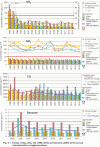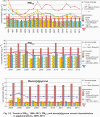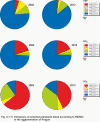V.1 THE CAPITAL CITY OF PRAGUE
As concerns ambient air pollution, the capital city of Prague
is ranked among the most loaded areas of the CR. This is the
result of the interaction of a number of natural factors,
particularly the effects caused by high concentration of
inhabitants and the dense transport network connected with it.
The specific location of Prague in the varied terrain of the
Prague basin significantly affects the climatic and dispersion
conditions of its territory (Ložek et al. 2005). The Vltava
river valley is usually poorly ventilated and especially in the
cold half of the year there are formed favourable conditions for
temperature inversions when the markedly warmer air is shifted
above the cooled air near the earth surface. Heavy cold air
remains near the earth and thus prevents the pollutants from
dispersion into the upper layers of the atmosphere. This results
in increased pollutants’ concentrations in the still ground-level
layer of air (Bednář, Zikmunda 1985).
Deteriorated ambient air quality in Prague is connected mainly
with significant traffic loads. Prague represents, due to its
geographical position, not only the main junction of the road
network in the CR but also the significant crossroad of
international transit transport. A large part of main routes
lead directly throughout the centre of Prague. The current
communication network in the inner city, however, is not able to
accommodate such huge concentration of traffic, and consequently,
it is overloaded and often even collapses occur. The situation
should be partly solved primarily by the completion of the ring
roads around Prague, by considerable reduction of private cars
in the most loaded areas and the emphasis on the railway and
public transport (IPR Praha 2012).
With regard to its historical development, Prague has also the
developed industrial infrastructure (IPR Praha 2012). In spite
of the fact that recently a lot of industrial plants not
complying with the set conditions for their operation have been
closed or reduced their production, there is a growing focus on
the sector of services. Consequently, new commercial and
administrative centres have been built which makes high demands
on transport services and consumption of energies, incl. heating.
Also consumption of fossil fuels for household heating in family
houses mainly in the city outskirts has a considerable influence
on the current air pollution situation in Prague.
V.1.1 Air quality in the agglomeration of Prague
Suspended particles PM10 and PM2.5
In 2013 the limit value for the average 24-hour concentration
of PM10 (the value 50 µg.m-3 must not be exceeded more than 35x
in one year) was exceeded in the territory of the Prague
agglomeration in 5 of 15 localities with sufficient number of
data for the evaluation (in 2012 the limit value was exceeded in
6 of 15 localities used for the evaluation in 2013). Three of
the above five localities are classified as traffic localities,
one as industrial and one as suburban background locality. At
approximately half of the stations both the average 24-hour
concentration and the number of exceedances of the limit value
decreased or stagnated, the other half of the stations, on the
contrary, recorded a slight increase. After more detailed
analysis it can be stated that in 2013 the slight decrease of
the average 24-hour concentration continued separately at
traffic and background stations. The difference between the
average 24-hour concentration at traffic stations and at
background stations continues to decrease as well – in 2013 it
was lower than 3 µg.m-3 (Fig. V.I.1).
In 2013, similarly as in the previous years, the annual PM10
limit value (40 µg.m-3) was not exceeded in any locality of 16
localities relevant for the evaluation of annual concentrations.
The average annual concentrations at traffic stations and at
background stations stagnate (Fig. V.1.2).
As a rule, high concentrations of suspended PM10 and PM2.5
particles and the most frequent exceedances of 24-hour limit
value for PM10 are reached in the cold period of the year due to
the higher emissions of TSP caused both by higher intensity of
heating (incl. local heating) and higher emissions from traffic
(increased abrasion of road surface by spreading and the
subsequent re-suspension of the abraded material; EC 2011), both
by less favourable meteorological conditions for the dispersion
of pollutants. In the agglomeration of Prague the level of 24-hour
limit value was exceeded most frequently in the months January–March.
The stations where the limit value for 24-hour concentration of
PM10 was exceeded, reached during the first three months from 50
% to 100 % of the permissible number of limit value exceedances
(Fig. V.I.3) when, due to generally lower temperatures, most
unfavourable dispersion conditions prevailed (Tolazs 2014;
Chapter III). With regard to above-the-average temperatures
during November and December, the number of exceedances at the
end of the year was lower in comparison to the year 2012.
The limit value for average annual concentrations of suspended
PM2.5 particles was exceeded in 2013 at one of four stations
with sufficient number of data for the evaluation. The limit
value was exceeded at the station Prague 2-Legerova classified
as a traffic station (hot spot). The PM2.5 concentrations were
measured there for the second time and the year-to-year
comparison shows the increase by more than 5 µg.m-3. The
remaining localities (Prague 2-Riegrovy sady, Prague 5-Smíchov
and Prague 5-Stodůlky), for which data are available for the
years 2012 and 2013, did not record any marked changes in the
values of average annual PM2.5 concentrations (Fig. V.I.4).
The trend of air pollution characteristics for PM10 is evaluated
on the basis of data from the stations for which there exists
the complete time series starting in the 90’s (Fig. V.2). The
steep drop of PM10 concentrations was recorded from 1996 to
1999. Then the concentrations increased again and in the period
after the year 2000, in the year 2003, the so far maximum levels
are reached due to unfavourable dispersion conditions in
February and December and due to subnormal precipitation amounts.
Since the year 2003 the overall trend of air pollution has had a
decreasing character, nevertheless there were fluctuationsin
individual years, mainly due to meteorological and dispersion
conditions. Higher PM10 concentrations were measured for
instance in the years 2006, 2010 and 2011. The 2013
concentrations reach the similar levels as those in the year
2012. The average annual PM10 concentrations remain below the
level of the respective limit value starting from the year 2004.
On the contrary, the 36th highest daily concentrations of PM10
with regard to the level of the daily limit value, show
fluctuations.
Nitrogen dioxide
The hourly limit value 200 µg.m-3 was exceeded in the
locality Prague 2-Legerova 6x and in the locality Prague
5-Smíchov 2x. The permissible number of exceedances is 18. The
hourly limit value for NO2 (200 µg.m-3) was thus not exceeded in
any of these localities in 2013.
With regard to the exceedance of the limit value in Prague,
there is a problem mainly with the traffic station Prague 2-Legerova
(hot spot) where NO2 has been measured since 2003. This station
is aimed at monitoring air pollution caused by traffic. In 2013,
for the second time since 2003, the hourly limit value was not
reached at this station (Fig. V.I.5).
The annual limit value for NO2 (40 µg.m-3) was exceeded in one
of 14 localities in the territory of the Prague agglomeration (Fig.
V.I.6), and namely in the locality Prague 2-Legerova (the annual
average concentration reached the value of 53.6 µg.m-3). In
2013, for the first time after several years, the traffic
station Prague 5-Smíchov did not record the exceedance of the
annual limit value.
Generally, it can be stated that NO2 concentrations in the
territory of the agglomeration of Prague decreased in most
localities in the year-to-year comparison. The average annual
concentrations of NO2 decreased again, and namely at almost 70 %
of the stations. The decrease was recorded in total average both
at background stations and at traffic stations (Fig. V.I.6). However, it can be expected that the exceedance of the limit
values can occur also in other localities exposed to traffic,
where there are no measurements.
The trend of air pollution characteristics for NO2 is evaluated
on the basis of data from the stations for which there exists
the complete time series starting in the 90’s (Fig. V.I). The
downward trend of NO2 concentrations of the 90’s stopped in 2000
and, on the contrary, the NO2 concentrations were increasing up
to 2003 when there were recorded similar concentration levels as
those measured in 1996. Higher concentrations of NO2 in 2003
were caused both by unfavourable dispersion conditions in
February and December and by subnormal precipitation amounts.
Since 2003 the air pollution characteristic of NO2 have not
shown any marked trends – in global they decrease, in the year-to-year
comparison, however, there are fluctuations mainly according to
the prevailing meteorological and dispersion conditions. The
increase of both the annual average concentration and the 19th highest 1-hour concentration was recorded in 2006 and 2011.
Since 2011 air pollution characteristics of NO2 have had a very
slight decreasing trend. From the beginning of the evaluated
period air pollution characteristics of NO2 remain below the
level of their respective limit values.
Benzo[a]pyrene
Problems are still caused by benzo[a]pyrene concentrations which in 2013 exceeded again the annual limit value at the station Prague 4-Libuš. In the year-to-year comparison the annual average concentration increased both at the station Prague 4Libuš and at the second station Prague 10-Šrobárova, where the limit value 1 ng.m-3 was reached. Benzo[a]pyrene concentrations in the evaluated period starting with the year 2000 reached the highest level in 2006; since then they do not show any marked trend and they fluctuate around the limit value 1 ng.m-3 (Fig. V.I.7).
Ground-level ozone
In 2012 (in the average for 3 years 2010–2012) the limit value for the ground-level ozone was exceeded in the suburban background locality Prague 6Suchdol where the 26th highest maximum daily 8-hour running average reached 122.6 µg.m-3 . The exceedances of the limit value in this locality occurred within the evaluated period repeatedly every year, in 2013 the limit value was exceeded 27.3x in the average for three years (the permissible number of exceedances is 25). Further high levels of the 26th highest maximum daily 8-hour running average, however not reaching the limit value, were recorded in the locality Prague 4Libuš (118.5 µg.m-3). Other stations measuring ground-level ozone in the territory of the agglomeration of Prague did not exceed the limit value (Fig. V.I.8). The lowest concentrations are measured at the traffic station Prague 9-Vysočany, which corresponds to the formation of ground-level ozone and the course of its concentrations (Chapter IV.4.3).
Other pollutants
As concerns other pollutants listed in the legislation (CO, SO2, benzene, heavy metals), the limit values are successfully met in the agglomeration of Prague in the long term. The concentrations of SO2, Ni and Cd exceeded the respective limit values at several stations in the 90’s; after the year 2000 there occurred above-the-limit annual average concentrations of arsenic at the station Prague 5Řeporyje, for the last time in 2011. Nevertheless, the concentrations of these substances also respond to the prevailing meteorological and dispersion conditions, and thus the increase of several air pollution characteristics of these pollutants was recorded e.g. in the years 2003, 2006, 2010 or 2011.
V.1.2 Emissions in the agglomeration of Prague
At present there are 2,400 individually registered plants –
sources of ambient air pollution in the territory of the
agglomeration of Prague included in the REZZO 1 and REZZO 2
database. However, only several of them have their significant
contribution to total emissions, primarily the cement plant
Cementárna Radotín and the heating plant Teplárna Malešice
(Pražská teplárenská, a. s. – PT, a. s.), the incineration plant
of communal waste of Pražské služby, other thermal energy
sources of PT, a. s., and the industrial plants, e.g. tyre
manufacturer MITAS, a. s. In the recent period also the share of
emissions from the production of electric energy in cogeneration
units has increased (e.g. ÚČOV PVaK and TEDOM Daewo-Avia Letňany).
As concerns heating in households and in the communal sector
there prevail central sources of heat energy (about 52 % of
flats) and gas boiler stations and local gas boilers (about 31 %
of flats). Significant share is contributed by electrical
heating (about 5 %) and other types of heating difficult to
classify (relatively high share of about 10 %). Only in a small
part of the housing stock, primarily in the city outskirts, coal,
wood and coke are used for heating.
In the period 2002–2012 all monitored emissions decreased in the
above significant sources. As concerns heat generating sources,
the decrease is connected with the implementation of the large-scale
project on interlinking the thermal energy supply system Mělník-Prague.
The essential decrease of SO2 emissions is related to reducing
the amount of hard coal combusted in the heating plant in
Malešice (starting from 2011).
In the nationwide perspective the emission load of Prague is
rather specific. The sources monitored as point sources and area
sources operated in the territory of Prague have, except for
some of them, minor significance, and the highest share of
emissions is caused by traffic (Fig. V.I.11). With regard to the
fact that significant sources have usually high stacks, their
share in air pollution is recorded often in the areas outside
Prague.
The decrease in reported TSP emissions of REZZO 2 sources is in
fact influenced to a certain extent by the change of the
reporting methodology as concerns emissions from quarries based
on the implementation of the provision on the method of
ascertaining the amount of emissions.
V.1.3 Conclusion
The capital city of Prague is an area where a lot of people
are exposed to ambient air pollution. In the agglomeration of
Prague the limit values for suspended particles, nitrogen
dioxide and benzo[a]pyrene are exceeded in the long term. The
limit value for ground-level ozone is exceeded in the outskirts
of Prague. Most of the limit values exceedances are connected
with significant traffic loads of the capital, but also with
household heating, mainly in the built-up areas with family
houses. The share of mobile sources in total emissions of TSP in
the agglomeration of Prague amounts to more than 85 %, in total
emissions of NOx to approximately 75 %.
Generally it can be stated that air pollution situation in the
territory of the agglomeration of Prague in 2013 is comparable
with the year 2012. Air pollution characteristics of PM10
particles area stagnant, nevertheless the limit value for the
average 24-hour concentration of PM10 was exceeded again at
several stations. The annual average concentrations of NO2
slightly decreased, the limit value was exceeded only at the
traffic station Prague 2-Legerova (hot spot). The concentrations
of benzo[a]pyrene and PM2.5 particles slightly decreased in
comparison with the year 2012. The numbers of exceedances of the
limit value for ground-level ozone in the territory of the
Prague agglomeration have remained at approximately same level
for several years. As concerns further pollutants, there is no
problem to meet their respective limit values.
Fig. V.1 Trends of SO2, NO2 and CO (1996–2013) and
benzene (2005–2013) annual characteristics in agglomerations
Fig. V.2 Trends of PM10 (1996–2013), PM2,5 (2004–2013) and benzo[a]pyrene
(2005–2013) annual characteristics in agglomerations
Fig. V.1.1 Number of exceedances of 24-hour PM10 limit value in
selected localities and the 36th highest 24-hour concentration
PM10 at individual types of stations, agglomeration of Prague,
2006–2013
Fig. V.1.2 Average annual PM10 concentrations in selected
localities and at individual types of stations, agglomeration of
Prague, 2006–2013
Fig. V.1.3 Number of days with concentrations of PM10 > 50
µg.m-3 in individual months, incl. total number of exceedances,
agglomeration of Prague, 2013
Fig. V.1.4 Average annual PM2.5 concentrations, agglomeration of
Prague, 2004–2013
Fig. V.1.5 Numbers of exceedances of the hourly limit value for
NO2 at the traffic station Prague 2-Legerova (hot spot),
agglomeration of Prague, 2003–2013
Fig. V.1.6 Average annual NO2 concentrations in selected
localities and at individual types of stations, agglomeration of
Prague, 2006–2013
Fig. V.1.7 Average annual benzo[a]pyrene concentrations,
agglomeration of Prague, 2000–2013
Fig. V.1.8 Numbers of exceedances of the limit value of O3 in
the average for three years, agglomeration of Prague, 2006–2013
Fig. V.1.9 Field of the annual concentration of NO2,
agglomeration of Prague, 2013
Fig. V.1.10 Field of the 36th highest 24-hour concentration of
PM10, agglomeration of Prague, 2013
Fig. V.1.11 Emissions of selected pollutants listed according to REZZO in the agglomeration of Prague












